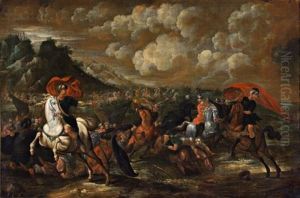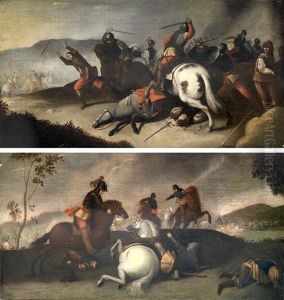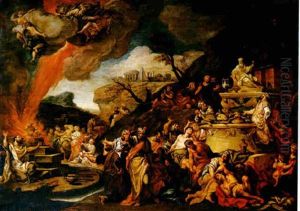Esteban March Paintings
Esteban March was a Spanish Baroque painter, born in Valencia, Spain, around 1610. He was known for his dynamic and dramatic style, which was highly influenced by the prevailing Baroque sensibilities of the time. March's work is characterized by intense emotion, strong contrasts of light and shadow, and a certain theatricality that was common among his contemporanean artists.
March's artistic education and early influences are not thoroughly documented, but it is believed that he was a pupil of the painter Jerónimo Jacinto de Espinosa, one of the most prominent artists in Valencia during the first half of the 17th century. March's style also shows the influence of Italian Baroque, particularly the work of Caravaggio, whose use of chiaroscuro and focus on realism can be seen in March's paintings.
While March's career unfolded during a golden age of Spanish art, with contemporaries such as Diego Velázquez and Francisco de Zurbarán transforming the Spanish artistic landscape, he did not achieve the same level of fame as some of his peers. Nevertheless, he was a respected artist in his own right, and his works were sought after by local patrons and religious institutions.
Esteban March's oeuvre primarily consists of religious subjects, though he also painted mythological scenes and was known for his skill in portraying dramatic narratives. His paintings often depicted moments of intense spiritual fervor or divine intervention, filled with expressive figures and an attention to detail that brought his compositions to life.
One of March's most notable works is 'The Vision of Saint Anthony', which showcases his ability to convey a mystical experience with convincing realism. The painting is a testament to his skill in manipulating light to create a focal point and guide the viewer's attention through the scene.
March's work was not limited to altar pieces and religious commissions; he also created a number of smaller paintings intended for private devotion or for the art market. These works allowed him to explore different themes and showcase his versatility as an artist.
March's death is believed to have occurred around 1660 in Valencia. While his work did not achieve the widespread acclaim of some of his contemporaries during his lifetime, he is now recognized as an important figure in the history of Spanish Baroque art. His paintings can be found in various museums and collections, where they continue to be studied and appreciated for their emotional power and technical mastery.








